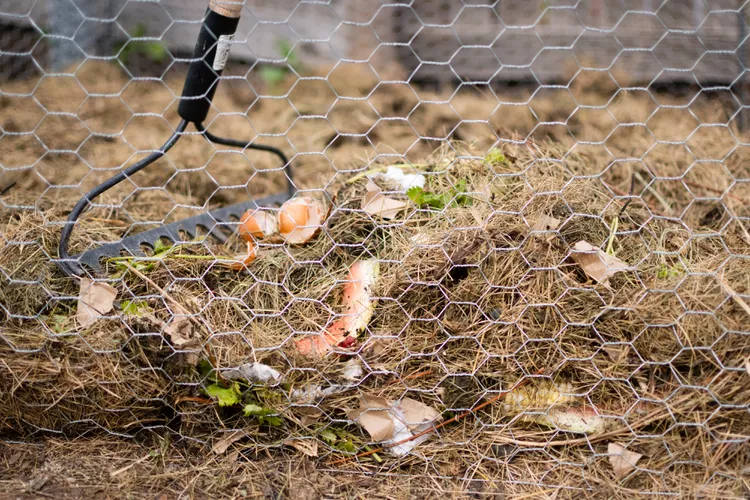How to Choose a Compost Bin
When choosing a compost bin, you have to think about how you plan to use the compost and how much you need. There are many styles of compost bins to choose from.
On the small end of the spectrum, kitchen composters are small, streamlined, and odor-free. For larger garden operations, you may want to contain your compost in an outdoor bin. A DIY or store-bought or container to hold the compost and can be made of any material you have access to, such as wooden pallets, cinder blocks, or plastic bins.
How to Make Compost
Add Green Material
Green material is high in nitrogen. It includes kitchen scraps such as coffee grounds, peelings, fruit cores, uneaten leftovers, and eggshells. Any kitchen waste that is not greasy or meat can be composted.
Grass clippings, leaves, and weeds are also considered green materials, as is manure from barnyard animals (but not cats or dogs).
:max_bytes(150000):strip_icc():format(webp)/how-to-make-compost-p2-1761841-03-b4cb90cf55154b638a7cef55447cdb9c.jpg)
Add Brown Material
Brown material is high in carbon. Paper, cornstalks, sawdust, small branches, twigs, and straw all fall into this category.
The ratio of nitrogen to carbon should ideally be 50/50 in your compost pile so for every bit of brown material you add, be sure to balance it with green material.
:max_bytes(150000):strip_icc():format(webp)/how-to-make-compost-p2-1761841-02-3a24b67b2d7d49868352b6b10613651c.jpg)
Add Water
Water is the final key ingredient in a thriving compost pile. Without moisture, your pile will take months to do anything and, if dry enough, will not break down at all. If your pile is too wet, on the other hand, it will smell and become slimy as the ratio of harmful bacteria outweighs the good.
You want the pile to remain damp but not dripping wet. If you do not get enough rainfall to suffice, dump a bucket of water over it once a week to keep things moving.
You will know that your compost pile is right if it becomes hot in the middle. Maintaining heat is important to sterilize the compost and kill the weed seeds or harmful bacteria that may be there. The heat is your proof that the ratio is working for your compost pile.
:max_bytes(150000):strip_icc():format(webp)/GettyImages-1334653822-cb857a760a2b40bdb49c88789656c6d1.jpg)
Turn the Pile Regularly
Whether using a compost bin or a simple pile, you will need to turn your materials with a shovel or pitchfork. Simply move the outer portion of the pile toward the center, turning each scoop over as you go. Continue shuffling the materials until you have exposed the decomposing materials within the pile.
A needs to be turned every two to four weeks. If you have a bin with a crank, give it a few turns every week.
If your pile heats up, is adequately moist, and gets turned regularly, you should have usable compost in one to two months.
:max_bytes(150000):strip_icc():format(webp)/how-to-make-compost-p2-1761841-04-db52ca7368194b2dae4e4419314bcb4b.jpg)
How to Use Your Compost
Now that you have compost, you need to know what to do with it.
- Fertilizer: Feed your perennials, bulbs, fruit trees, container plants, or lawn. Top dress or sprinkle some on top of your new or established plantings.
- Mulch: Apply a 3- to 6-inch layer of compost to the soil surface instead of using mulch, it will prevent water evaporation from the soil, keeping it moist longer, and it will also discourage weed growth.
- Potting soil: To make an enriched potting soil, use equal parts compost, vermiculite, and topsoil, mix thoroughly.
- Compost tea: Brew compost tea. By making a liquid emulsion, you get a concentrated fertilizer that quickly reaches your plant’s roots.
What Not to Put in Compost
Some materials will create a smelly pile, attracting rats and other vermin, so they should not be used for composting.
Items that should not be used for compost include:
- Meat and fish
- Dairy, fats, oils
- Woods treated with preservatives
- Diseased, pest-infested plants, or invasive weeds
- Charcoal ash
- Dog and cat waste
Any items treated with pesticides or acidic things like charcoal ash can kill the bacteria in your pile. Dog and cat poop may have harmful bacteria or parasites that turn your fertilizer into hazardous waste.
Avoid putting leaves or other plant parts that show signs of disease or fungal spots. These pathogens may survive the heat of the composting process and be transported back into the garden when you eventually use the compost. Unhealthy plant material should be bagged up and taken away.
Additional Compost Care Tips
- A compost pile can be started any time of the year, although, in winter, decomposition will slow down.
- If your compost heap starts to smell, it probably contains too much water; allow it to dry out by turning and not adding additional water for a few days.
- Other odor-causing issues include adding too many greens and not enough browns or having meats or oils in your heap.
:max_bytes(150000):strip_icc():format(webp)/how-to-make-compost-p2-1761841-05-8db5ab61594d428c925e6711de8420d8.jpg)
-
What are the four ingredients needed to compost?
The four ingredients you need for composting are air for the oxygen, water for the moisture, green materials which are nitrogen-rich materials, and brown materials which are carbon-rich materials.
-
What should you not add to compost?
Some items to avoid adding to your compost are meat and fish, dairy, fats, and oils, woods treated with preservatives, charcoal ash, and dog and cat waste.
-
Do you water compost every day?
You want the pile to remain damp but not dripping wet. If you do not get enough rainfall to suffice, dump a bucket of water over it once a week to keep things moving.


